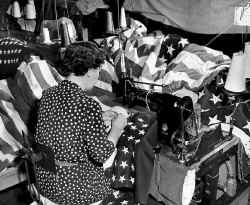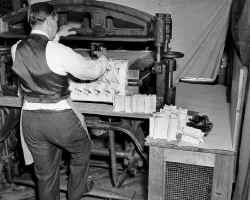by John V. Haggard
Philadelphia Quartermaster Depot Historian
Undated Document (1950s era)
from the Quartermaster Museum Library
Short history of flag production at the Philadelphia QM Depot

The Betsy Ross flag-making story brought to life after the Civil War has been growing since then and is now accepted as a tradition by many Americans. Its resounding echo has reached even the Philadelphia Quartermaster Depot.
According to the statement attributed to Betsy Ross, sometime before 4 July 1776 George Washington, Robert Morris, and Colonel George Ross honored her humble shop on Arch Street with a personal visit to commission her to make the flag. Washington spread out a design before her and asked her to make a flag with seven red and six white stripes and thirteen white six pointed stars on a blue field. He explained that he believed the six-pointed stars would be easier to make than the five-pointed ones. The young Quaker widow promptly folded a piece of paper in a certain manner, deftly snipped it with her shears, and unfolded it to display a symmetrical five-pointed star. Whereupon Washington agreed to let her make five-pointed stars for the flag. Working late into the night of the next day, Betsy Ross finally completed and delivered the flag to the Commander-in-Chief.
Although extant records show that she made other flags and was paid for them in May, 1777, by the State Navy Board, basic documentation is lacking for the substance of her statement. Nevertheless, the Betsy Ross story, despite this academic paucity, bids well to become a cherished symbol and part of the great American heritage.
Once the flag was officially adopted by the Continental Congress on 14 June 1777, the demand for flags must have grown beyond the capabilities of one Betsy Ross to supply it, and it must have become necessary for the many seamstresses of Philadelphia to assist in the profitable occupation of flag-making. This is not a completely unfounded assumption, for event then Philadelphia was rapidly becoming a great textile and clothing center for the incipient republic. Furthermore, the struggling Government, which had its capital in Philadelphia most of the time, was intensely interested in providing clothing and equipage for its military and naval forces.
Soon after the Revolutionary was concluded, the Government established the Schuylkill Arsenal–which is today considered the predecessor of the Philadelphia Quartermaster Depot–as a storage and distribution center for Army clothing, textiles, and equipage. As early as 1800 cut parts of garments were being distributed from the Public Stores on Water and Race streets to Philadelphia seamstresses to be made into finished garments for the small Army of that period; and by 1809 these cut parts were being distributed from the Schuylkill Arsenal. As the demand for military clothing fluctuated, increasing in time of emergency and decreasing in time of calm, the number of seamstresses engaged by the Schuylkill Arsenal also varied. Seamstresses and tailors went to the Arsenal from Philadelphia and the surrounding vicinity by any transportation means available to deliver finished garments and obtain cut parts for more end items. At one time during the Civil War ten thousand people were employed throughout the Delaware River valley making Army uniforms by hand. Flags were also made by these seamstresses.
Although it is not possible to establish the exact origin of flag-making at the Schuylkill Arsenal, it is definitely known that Flag and Embroidery Sections have existed in the Depot Factory since the dawn of the twentieth century. In 1917, because of the greatly expanded demands of World War I, these Sections were moved form the Schuylkill Arsenal to temporary quarters in the Fleischer Building on 26th and Reed streets; but in 1920 they were returned to the Arsenal. The following year, along with other segments of the Factory, these two Sections were moved from the Arsenal to the newly erected Inland Warehouse, later to be known as the Philadelphia Quartermaster Depot, at 2800 South Twentieth Street, Philadelphia, Pa., its present location.
World War II created such great demands for all types of flags that the Flag and Embroidery Sections were forced to expand their activities tremendously. One hundred and forty-five people were engaged in manufacturing flags, brassards, chevrons, guidons and other heraldic items. These modern followers of the Betsy Ross tradition not only made numerous copies of the national colors but spent many diligent hours manufacturing debarkation markers essential to military operations on the French coast in June 1944. These six-foot square fluorescent markers, manufactured expeditiously as Secret items, greatly facilitated the landing of supplies and equipment on the Normandy invasion beach.
No longer do these flag makers depend on deftness of fingers for the production of artistic emblems. In contrast with the hand technique employed by Betsy Ross and her followers in the Revolutionary War and the period before the Civil War, the flag makers of the Philadelphia QM Depot Factory today have at their disposal the latest equipment and machinery available. Some of these machines were developed by flag makers and other Factory employees. Flags of the United States are manufactured at the Depot shop only when required by emergency conditions, since these flags are procured from industry. Standby equipment, however, included electrically driven machines which can stamp out 50 stars in each stroke and can produce 10,000 stars in one day. The emergency equipment includes zigzag machines which attach the stars to the background and a specially constructed device which lays and aligns the stars neatly in rows upon the blue field.

Despite the progress achieved by American industry and the ingenuity of the Depot flag makers, no machine has yet been devised that can equal the artistry of the people in the Embroidery Section of the Depot Factory. It would be practically impossible to achieve by machine the fine shading and color blending that is accomplished by hand. The realistic effect of such artistic detail as the eagle’s feathers cannot yet be stamped on silk as deftly by machine as by the hands of the many experts of the Embroidery Section, some of whom have had as much as a quarter of a century of embroidery experience. Many of the flags and colors made by these artists require a skill of the highest order. Such flags as the one for the President of the United States, those for Cabinet members, certain foreign countries, and the regimental colors with their intricate and individually adopted coats of arms, scrolls, crests, and other details demand the most painstaking effort on the part of the embroiders of the Depot Factory.
The cogent reason of economy also demands that this delicate phase of flag production be accomplished by hand. Inasmuch as the coat of arms, scrolls, mottoes, or crests are different for each organization, the cost of developing machine patterns to embroider the limited quantities of each separate flag that are normally required would be prohibitive.
Notwithstanding its long history, the flag making activities of the Philadelphia QM Factory had never produced flags in large or competitive volume. The Depot Factory flag makers are an auxiliary group that can supplement the commercial flag making capacity of the nation when necessary. They form a nucleus that preserved the basic skills needed in time of emergency for rapid expansion along with other features of the national economy. Their skill and experience are thus preserved to carry on the flag-making tradition at the Philadelphia Quartermaster Depot in war and peace.
